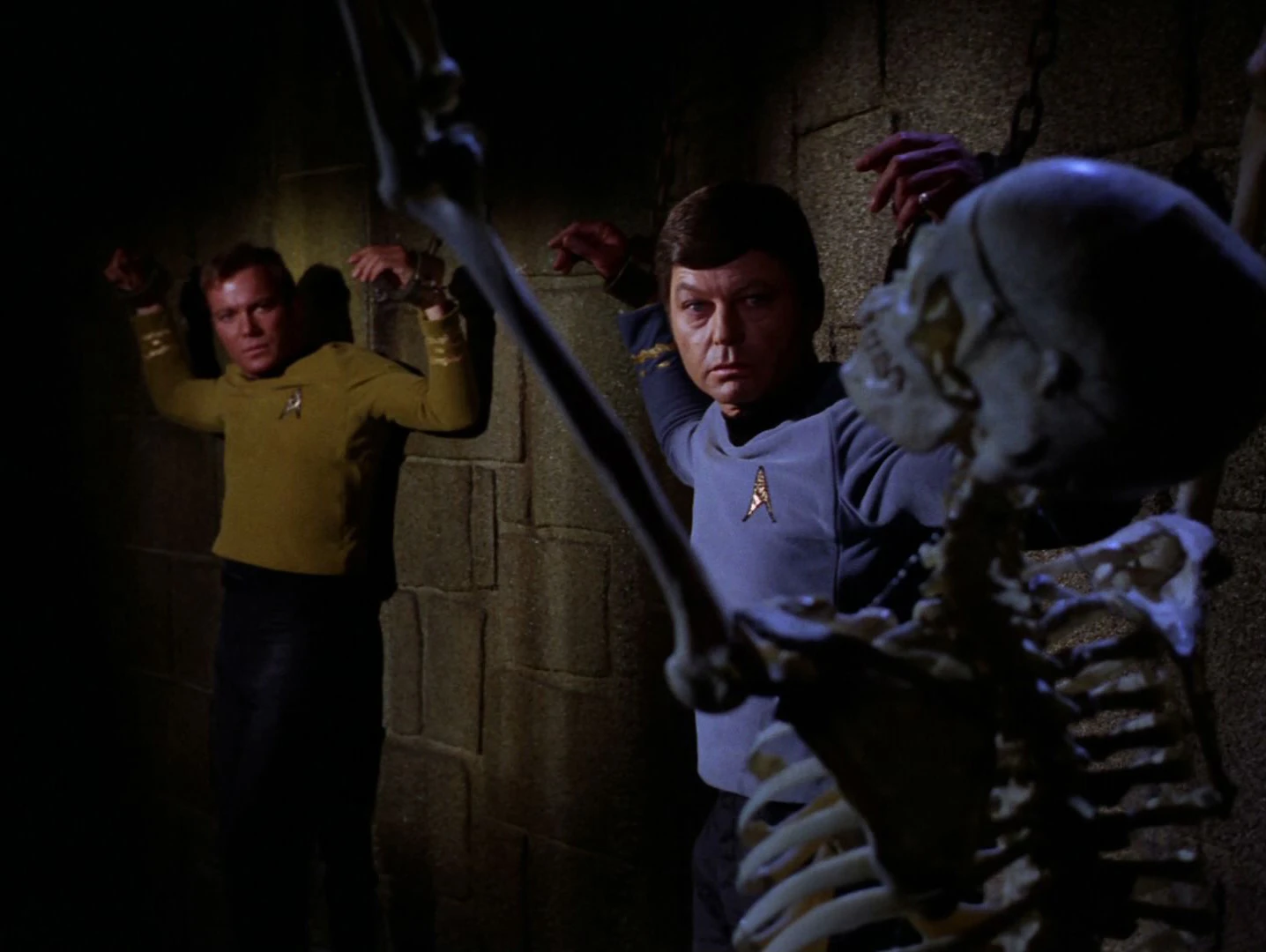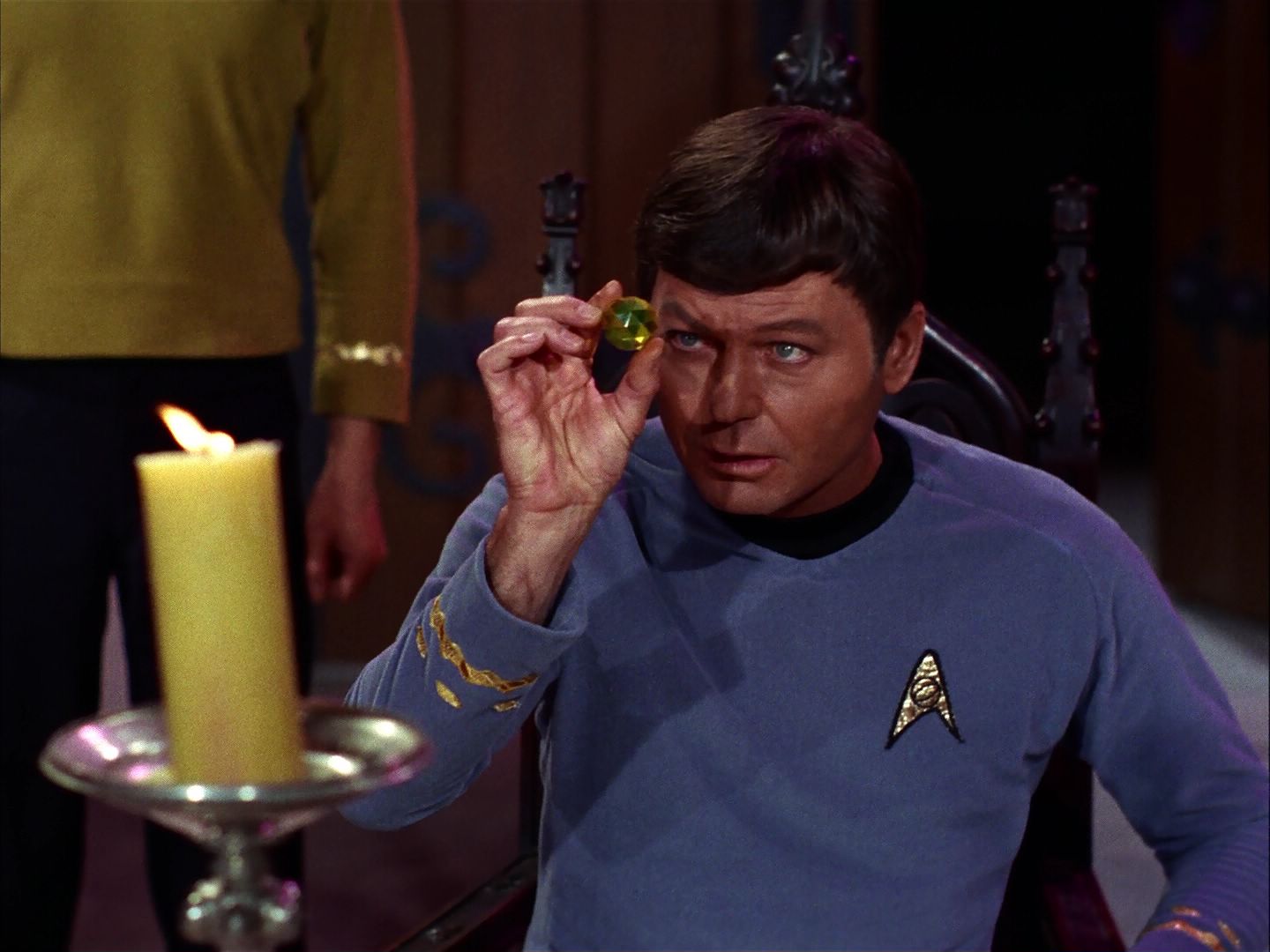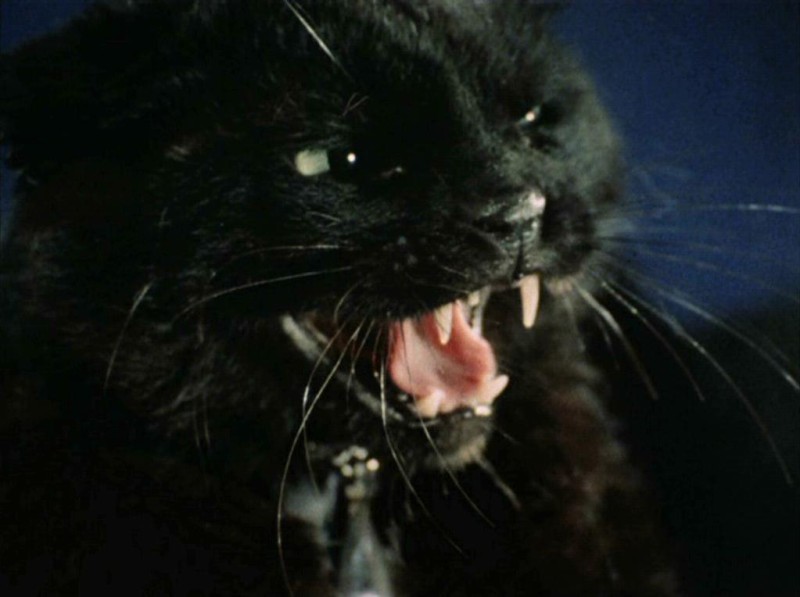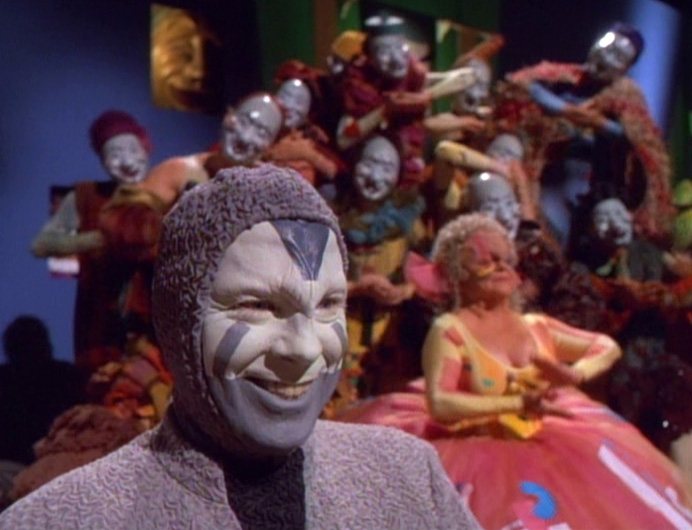Star Trek: The Original Series – “Catspaw” (season 2, episode 7)

Written by Robert Bloch; directed by Joseph Pevney; first aired in 1967
(IMDb | Memory Alpha)
Captain Kirk, Spock, and Bones beam down to a planet in search of Sulu and Scotty, after their fellow away team member, Jackson, beams back to the Enterprise alone … and dead. On the planet, Kirk and company find fog, and witches, and a big old creepy-looking castle, none of which, obviously, should be there. After entering the castle and immediately falling into a trap, they wake to find themselves chained to a wall, before being escorted by a mind-controlled Sulu and Scotty to meet Korob and Sylvia, who appear human but are dressed in the regalia of a sorcerer and sorceress from fantasy novel (when Sylvia isn’t appearing as a black cat, that is). The two turn out to be your standard nearly-all-powerful entities from another universe, newly arrived on the planet and recreating horror imagery from the human subconscious in their semi-successful attempts to probe and communicate with human minds. While Korob is somewhat impressed with the humans he has encountered, lesser life forms though they may be, Sylvia is more taken with her ability to play with humans and hold their lives in her hand – almost literally, as she dangles a tiny replica of the Enterprise over a candle flame, heating the real starship to near-unbearable temperatures. She’s also quite taken with Kirk, who indulges her a bit, but is understandably more concerned with saving his crew. Disapproving of Sylvia’s addiction to the power she wields over the life forms of this universe, Korob helps Kirk obtain the magic wand – really a “transmuter” – that allows them to maintain their humanoid forms. After Sylvia, now a giant black cat, incapacitates Korob, Kirk manages to destroy the transmuter, undoing all the aliens’ “magic”… and leaving them to perish in their tiny original forms, not suited to this universe.
VS.
Star Trek: Voyager – “The Thaw” (season 2, episode 23)

Teleplay by Joe Menosky; story by Richard Gadas; directed by Marvin V. Rush; first aired in 1996
(IMDb | Memory Alpha)
The crew of the Voyager discover a lifeless planet which Neelix recognizes as having once been a thriving trade hub, before its population and infrastructure were seemingly wiped out by a solar flare, nineteen years earlier. Not entirely wiped out, though, as the crew discovers when an automated communication from the planet informs them that some of the planet’s people have gone into stasis with plans of awakening after fifteen years to go about restoring the planet’s ecosystem, and asks that any alien visitors not disturb this process. But given that the aliens appear to be four years behind schedule, Captain Janeway has their stasis pods beamed aboard Voyager to be investigated, and finds that only three of the five aliens are still alive and in stasis, while the other two appear to have died … of fear. In order to find out what happened to them, and why the other three have remained in stasis, Ensign Kim and Lt. Torres use the open pods to join the aliens in stasis, where all their minds are connected in a computer-simulated environment. Finding themselves in a surreal circus atmosphere ruled by a creepy clown, they’re almost beheaded in a bright, cheerily-colored guillotine before the alien from the pre-recorded message, Viorsa, begs the Clown to stop, reminding him that there will be more alien visitors where these two came from. Kim and Torres discover that the Clown is the monitoring A.I.’s manifestation of the fear Viorsa’s group felt upon the destruction of their world, and that he can manipulate the virtual world and read any mind he’s linked to, albeit with a several-minute delay. The Emergency Medical Hologram is sent into the program to communicate with Kim, Torres, and the others, but has little success negotiating with the volatile and unpredictable Clown, who tortures Kim with traumatic memories, and eventually has Viorsa executed in the guillotine, scaring his body, in the stasis pod, to death. Finally, Janeway offers herself in exchange for her crew and the remaining aliens, and the Clown excitedly agrees, eager to meet her based on what he’s learned about her from reading Kim’s mind. But once the others are out, and before his delayed mind-reading allows the Clown to sense her, “Janeway” reveals that she’s only a holographic recreation of the real captain, and that without any organic brains to link to, the Clown will “eventually vanish,” “like all fear.” He announces that he’s “afraid,” as the episode ends with a close-up on his face which slowly fades to black.

At the risk of dating myself, one of the clearer memories from my childhood is of watching the first episode of the two-part TV miniseries It – the one starring Tim Curry as Pennywise the murder-clown – and being so terrified by it, as a 10-year-old, that I couldn’t sleep at all that night. My parents prevented me from further traumatizing myself by watching the second and final episode the following week, and these being the pre-streaming, pre-DVD days of “appointment viewing” and expensive VHS tapes, it would be about a decade before I’d finally rent the miniseries (yes, rent a physical copy from a physical store), re-watch the first half, and complete the experience by watching the second half for the first time.
The second half was … well, not exactly worth the wait. Having read Stephen King’s source material by that point (after reaching a more appropriate age for murder clowns), I knew that the clown façade of Pennywise (who would always, and will always, be Tim Curry to me) is eventually replaced by more conventional monster imagery in time for his final showdown with the now-grown-up teens he’d tormented. And I think I’d already found this later form of Pennywise less disturbing, less effective, in my reading of the novel, but on the screen – rendered in 1990 TV special effects – it was … well, it made me feel pretty silly for literally losing sleep over this miniseries when I was younger. That said, I remember the first episode actually holding up not too badly a decade later (though it’s been another couple of decades, now, since that second viewing, so don’t quote me on that), thanks to the genuinely unnerving creepiness of Pennywise in clown form; somehow, even being more familiar with Curry’s reputation for campy, delightfully over-the-top performances by my second viewing only seemed to enhance the clown’s creepiness, and 1990 effects or not, a character’s late younger brother winking at him out of his picture in the family photo album still creeps me out, to this day, just to think about.

All of which is to ask, in a roundabout way: if we ever encountered aliens, and had to explain to them both the human emotion of fear and the hobby of horror fiction, how would we? I’d assume that any life form capable of communicating with us, however alien, would at least understand the experience of fearing for one’s own health or safety, and for that of those they care about. But would they understand why made-up monsters scare us? Why we choose to let them scare us? Why we make them up in the first place? And why some of those made-up monsters are a lot scarier than others?
For me, watching It as a cheesy made-for-TV miniseries at too young an age, what scared me the most, I think, were the things that weren’t overtly monstrous, in an immediately obvious way, but were just, somehow, off. Things that looked familiar or non-threatening, but felt wrong, behaved wrong. In the story, Pennywise sometimes uses familiar monster-movie imagery to scare his young victims – appearing as a werewolf, for instance – but I don’t think this bothered me so much. A werewolf is a monster. That’s what it’s supposed to be. But photos of dearly departed relatives aren’t supposed to smile and wink at you. Family photo albums aren’t supposed to bleed. And colorful circus clowns are supposed to be cheesy, innocent entertainment, not the stuff of nightmares (or at least that’s what I thought back then, before decades of pop culture convinced me that clowns are absolutely not, under any circumstances, to be trusted). Even today, I’m no horror buff – I’m only marginally less of a wimp than that ten-year-old who literally lost sleep over a clown played by Tim Curry, of all people – but whenever I do enjoy something scary, from the excellent film It Follows (no relation to the above-mentioned It) to the excellent game Soma, the horror elements I find the most effective aren’t the jump scares or the obvious threats, but those off moments that make you feel like you’re trapped in some kind of uncanny valley, where the world has somehow tipped forty-five degrees off its usual axis. Your mileage may vary, obviously, but to me, the scariest thing in fiction are those moments of wrong-ness that hint at everything being wrong – moments that take us beyond our fight or flight impulses, because how do you fight, or flee from, the world, when it’s not working the way it’s supposed to?

And in case you were wondering when I would get to the Star Trek, already, I think that this is very much the takeaway from Trek’s reflections on the nature of fear, and how fear fits into the human experience, in The Original Series’ “Catspaw” and Voyager’s “The Thaw,” where the more “primal” fears fall flat, for the characters and for us, while what’s really creepy is a nice, comforting fantasy world gone rotten.

In “Catspaw,” Kirk, Spock, and McCoy find themselves surrounded by the stuff of stock Halloween imagery – fog and witches and ancient castles and cobwebs and black cats and skeletons – and are not particularly terrified by any of it. They are afraid, of course, that the mind-controlled Sulu and Scotty may suffer the same fate as their fellow away team member, Jackson, and that Korob or Sylvia might use their seemingly limitless power to destroy the Enterprise, and everyone aboard it. These are immediate, obviously sensible fears, after all, under the sci-fi circumstances. But while they’re confused and taken aback by Korob and Sylvia’s recreations of such stale ghost-story tropes as cackling witches and chained-up skeletons, they never appear actually scared by them, and instead find themselves discussing why anyone would find these images frightening, and why Korob and Sylvia might have bothered to recreate them. Spock suggests that the aliens had accidentally tapped into “universal” fears, but the resulting horror imagery is too broad, too generic, to be particularly scary for anyone, serving instead as comic relief at points, as when a chained-up Kirk realizes that the Bones he’s speaking to is, himself, chained up next to a literal set of bones, and opts to address his chief medical officer as “Doc,” instead.

All of which has, perhaps unfairly, made “Catspaw” something of go-to example of the silliest low-budget cheese that Star Trek, and The Original Series in particular, have to offer. Yes, some elements of this episode probably come off a lot sillier on screen than they were meant to; I’m assuming that Sylvia’s final form, as a cat so giant we only ever get glimpses of its snarling face on the other side of a doorway far too small for it, was probably meant to seem like more of a threat than it ever possibly could, given the laughably low-budget execution of the effects involved. But at worst, moments like this give the episode a certain B-movie charm; at best, the episode is actually quite clever, I think, in its self-aware use of deliberately cheesy horror tropes to convey the aliens’ inability, for all their obvious power, to understand life forms supposedly lesser than themselves. If anything, as tempting as it might be at first casual glance to write “Catspaw” off as an embarrassingly bad episode, I’d argue it suffers most from how unremarkable it is among Original Series episodes. From the away team that needs rescuing, to the aliens with seemingly godlike powers to manipulate minds and create objects and structures out of thin air, to the whirlwind romance between Kirk and the only woman in the episode who isn’t a recurring cast member, every aspect of “Catspaw” except the stock horror imagery can be found in any number of other Original Series episodes, many of which are more compelling to watch; even my favorite thing about the episode, that clever undercutting of the “superior beings” who are subtly shown not to understand humanity – and by extension, the universe – as well as they think they do, had already been done in the first-season episode “The Squire of Gothos,” and while Antoinette Bower and Theo Marcuse give fine performances as Sylvia and Korob in “Catspaw,” “Gothos” anchors its very similar premise around the much more memorable performance of William J. Campbell as Trelane.

Voyager’s “The Thaw” could, perhaps, be similarly accused of going back to the old well of super-familiar Star Trek tropes to build its basic premise: a hidden pocket of survivors on a long-dead world take refuge in a computer-simulated environment where they are at the mercy of a near-omnipotent artificial intelligence, who turns their refuge into a surreal nightmare to suit its own whims. Even the design of the Clown’s virtual world feels almost like a throwback to the relative simplicity of 60s television set design seen in The Original Series, thirty years before this episode’s production. But all that familiarity only serves to highlight how deeply, impressively weird “The Thaw” is. Very much unlike “Catspaw,” “The Thaw” doesn’t really feel anything like your average episode of Star Trek from the time in which it was produced. Throughout most of its history, and certainly during its 90s “golden age,” Star Trek has tended to rely on a pretty straightforward “house style” in its plotting and direction, largely leaning away from more stylized or experimental flourishes in the way narrative is presented to the audience; there have always been notable exceptions to this, of course – the shifting, unreliable reality of The Next Generation’s “Frame of Mind” and the campfire ghost story framing device in Voyager’s “The Haunting of Deck Twelve” are two examples that come immediately to mind – but these exceptions are notable precisely because they create such a different viewing experience than we typically expect from Star Trek. And “The Thaw” is nothing if not a … different viewing experience.

Like “Catspaw,” “The Thaw” is punctuated by dialogue from our Starfleet characters on the nature of fear: the purpose it serves; why we create whole new inventions, like roller coasters, seemingly just to experience it; and the power it does or doesn’t have over us. And frankly, these philosophical ruminations don’t go any deeper, or feel any fresher today, than those in “Catspaw,” three decades earlier; I’m not sure that “The Thaw” has anything all that insightful to say about fear. This episode’s strength is, instead, in the atmosphere it creates, the horror movie experience it replicates better than almost any other episode of Trek, in my opinion. It’s not hard to see how this could be a polarizing episode for its audience, given that we appear to be watching a pretty standard episode of Star Trek through the first few scenes, until Ensign Kim and Lt. Torres enter stasis and join the alien survivors in their simulated world, at which point “The Thaw” springs a wild tonal shift on us, with very little warning. And however sophomoric its dialogue on the nature of fear might be, the episode clearly understands a great deal about the nature of fear, and shows that understanding, instead of telling … and not just by making the embodiment of fear a creepy clown, either (though that certainly doesn’t hurt).

No, “The Thaw” doesn’t just understand that clowns are creepy, it understands why they’re creepy – why the undisputed champion of camp, Tim Curry, could put on traditional clown makeup and terrify a ten-year-old me to the very core of his soul, and why another brilliant actor known mainly for comedy, Michael McKean, can dress up as an alien clown and turn a regular weekly episode of Star Trek into something deeply weird and genuinely unsettling, even for adults. Beyond the fight or flight reflex, beyond your standard jump scare, to be afraid is to be thrown off balance, to see the expected order of things disrupted just enough that you’re left unsure of how the world around you works, and of how you can safely interact with it. As overused as the premise of an arrogant all-powerful entity, alien or A.I., might be in Star Trek, this is, I think, exactly why Trek’s writers return to that premise as often as they do: it taps into the universal fear, as Spock might put it, of finding ourselves completely at the mercy of unknowable whims which can’t be anticipated, avoided, or even understood, against which neither fight nor flight is effective. For that all-powerful entity to be a clown (supernatural in Pennywise’s case, but of the A.I. variety in “The Thaw”) only adds to the wrong-ness of it all – not to mention the irony – given that clowns are at least meant to be the epitome of a harmless entertainer performing for the whims of their audience, not their own, whether in the circus or at a child’s birthday party. And yes, it’s unfair to view clowns that way, as the performer under that greasepaint is of course a human being with a life of their own. But that, too, feels like an important part of the murder clown mythology, of which both Pennywise and Michael McKean’s Clown are extreme but logical extrapolations: the anxiety of realizing that those tasked with entertaining us have lives and unpredictable minds of their own, and that we have, therefore, entrusted the most innocent and harmless of entertainment to someone who could be anyone under all that clown makeup.

And this is why the off-kilter tone and general weirdness of “The Thaw” works so well for me. Both the characters and the audience are kept constantly aware that the Clown’s unending circus, the A.I. that has created it for the aliens and Voyager crew members in stasis, and the episode in which these things are depicted are all refusing to play by any expected rules, refusing to indulge the characters’ or audience’s whims and imposing their own whims, instead. From the moment we first see him, the drab, muted colors of the Clown’s appearance clash with our expectations of clown makeup and outfits; this could of course be explained through alien cultural differences, but such an explanation wouldn’t change the initial expectations of the audience. Those in the audience who recognized McKean’s name in the credits, or his face under the Clown’s makeup – especially when “The Thaw” first aired, while he was still more immediately associated with comedic work like This is Spinal Tap than with serious dramatic roles like the one he would later take in Better Call Saul – probably came in expecting a relatively light-hearted performance, and received an impressively creepy one instead. And those in the audience expecting the score and staging of this episode to conform to the usual conventions of Star Trek have to be knocked off balance when the score sticks to a circus theme even as characters are marched toward a guillotine, or when the circus crew all laugh with the Clown in perfect unison, in a way that can’t help looking comedic on screen, even as we’re well aware of the life-or-death stakes for our characters.

And all of this deliberately unsettling uncertainty culminates, of course, in one of the most unusual endings of any episode of Star Trek, when the story of our main characters, after they escape, is abandoned entirely so that we can be left solidly in the perspective of the Clown himself, as he slowly disappears without living minds to sustain him. Again, the holographic decoy Janeway’s words to the Clown about “fear only existing for one purpose: to be conquered” don’t carry as much philosophical weight, for me at least, as they may have been meant to, and at worst they could feel like a denial of the very real ways in which some real-life fears don’t “vanish,” but instead lead to lasting trauma. But that doesn’t lessen the arresting weirdness of the final scene, and it could be argued that holo-Janeway’s words are cleverly undercut by the way “The Thaw” leaves us to ask ourselves, after its end credits have rolled, “If all fear eventually vanishes … why do I feel so weirded out by that ending?”
